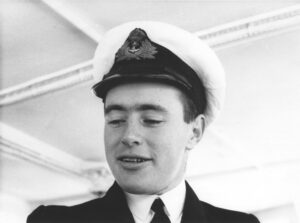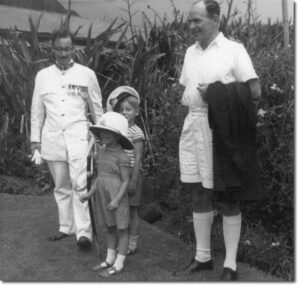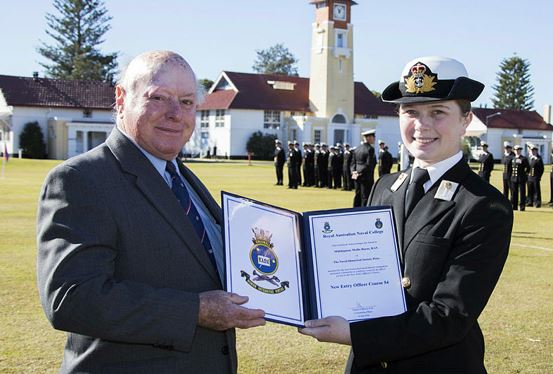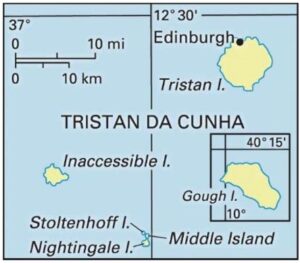- Author
- Editorial Staff
- Subjects
- Biographies and personal histories
- Tags
-
- RAN Ships
- None noted.
- Publication
- June 2023 edition of the Naval Historical Review (all rights reserved)
The Naval Historical Society is an association of individuals bound together by a love of the navy. Occasionally a member of this band of brothers and sisters stands out from the crowd and one of these was John Smith. John celebrated his 90th birthday on 24 December 2022.
A couple of weeks beforehand John, who was becoming a little unsure on his feet, shuffled up to my desk and said: ‘Wal, did I ever tell you about when I was shanghaied on Tristan da Cunha?’ Now to the raconteur John, this was his invitation to transmit and for me to receive. Sadly, I was busy at the time, so after a few minutes, I said: ‘This is great but do you think you could jot down a few notes and then we can get together and produce a story for our magazine’.
Time was not on our side and this was the last time I was to see John, who passed away on 3 February 2023, and so I never knew of his exploits on Tristan da Cunha. Recreating this story is but a small tribute to our great friend and colleague Commander John Smith RAN Rtd. But all was not lost as in our archive we discovered an audio recording made in June 2018 with John in full flight at the Chatswood RSL telling his tale of ‘Napoleon, the Royal Navy and Me’ which contains much of this detail. A copy of this talk is available on the Society’s website.
Like most good gunners, John was a secret admirer of that fellow artilleryman Napoleon and was especially taken by that great tribute to his defeat in Tchaikovsky’s 1812 Overture. Listen carefully to a recording of the 1812 and in the background to the intense cannon fire you hear the Marseillaise and the Russian Imperial Hymn.
John Smith
It must have been an exciting Christmas in the small New South Wales coastal town of Coffs Harbour as on 24 December 1932 Donald and Edna Smith were blessed with the birth of their first born. With no fancy middle names the baby was just plain John Smith.
Donald Smith had served as a Torpedoman with the Royal Navy but in September 1925 as a Leading Seaman he was loaned to the Royal Australian Navy; later as a Petty Officer he transferred to the RAN. After arriving Down Under he met and married Edna and upon his discharge from the navy in 1932 they tried their hands at banana farming in the fertile plains around Coffs Harbour. But only two years later in January 1934 Donald1 re-entered the RAN. This resulted in the family moving to the Sydney north shore suburb of Lane Cove where young John grew up through the war years and attended North Sydney Boys’ High School. Slight of build and bookish, he excelled academically and it was no surprise that he passed the rigorous entrance examination2 to join the Royal Australian Naval College.
With fifteen other lads John joined the College, then at Flinders in Victoria, on Wednesday 30 January 1946 as first year Cadet-Midshipmen, where John became ‘Smithy’. With three other years ahead of them there was a total cohort of 64 students. The first post-war entry was known as ‘Cook Year’ and we can thank those who contributed to a small Year Book to learn from their experiences. Cook Year was unique, being the first peacetime intake after six years of war. It was a time change but with naval training methods steeped in tradition it was some time before a more enlightened approach took hold. At this time the co

llege was, in many respects, an outmoded boarding school run by senior fourth year cadets who believed in discipline, especially of the recently joined juniors.
Reading the College magazines there was a heavy emphasis on sport and athletics with perhaps not so much scope for the more serious minded. Boxing featured as a major sport which suited larger country lads. Some of these experiences left a lifetime impression on John as in later life he was to conduct an analysis of the success or otherwise of Cadet Captains in future promotion stakes. Also leaving a few scars, he produced a paper on boxing in the RAN.
John, who was not given to criticism of naval life, experienced a deal of ‘character building’ which now would be referred to as bullying if not brutality. But these were the days when we were welcoming bemedalled heroes back home, and then laying them off, as the peacetime navy had to greatly reduce its number of ships and manpower. Like many others of his colleagues John had the benefit of coming from a family with parents or close relatives with war-time service, they therefore had some idea of naval culture before joining the college. But overall the youngsters moulded, possibly for survival, into a close knit team and after the first year with further maturity and self-reliance a little more enjoyment came into their lives.
Survival was a great attribute to Cook Year as of the sixteen originals, seven had fallen by the wayside by the time of graduation, and another resigned a year later. On the positive side, most of those who left the college adjusted to new roles in civilian life and maintained contact with their uniformed colleagues.
Service with the Royal Navy
John graduated from the Naval College in 1949 with a First Class Certificate, walking away with an academic prize. Together with his term-mates he was then off to Blighty to be introduced to the bigtime navy and undertake training courses in the cruiser HMS Devonshire. As a training ship. Devonshire had most of her 8‑inch armament removed, making way for accommodation for over 100 cadet-midshipmen; about half of these came from the RN plus some senior entries, and the remainder from Commonwealth navies – they all had to sling hammocks. There were two training cruises, a winter cruise to the West Indies and a summer cruise to Northern Europe and the Mediterranean.
In July 1950 the aircraft carrier HMAS Sydney returned to the UK to embark an air group of Sea Furies and Fireflys and to conduct training with the RN. When anchored at Torbay on 1 September she embarked five RAN Midshipmen: H.J.P. Adams, T.A. Dadswell, P.A. Hawke, R.J. Simmonds and of course J. Smith. Unbeknown to these MIDs there were two trains which could take them to Torbay, a fast train and a slower stopping train. They were issued with tickets for the slow train and as a result were late on board. Accordingly, they were all placed on charge, brought before the Commanding Officer and given three month’s stoppage of leave – not quite a warm and friendly welcome back to the RAN.
Further training was conducted around the UK before returning home, arriving at Sydney in time for Christmas. The New Year saw workup off the Australian east coast before they were bound for operational service in Korea. As a memorable event John sat his Midshipman’s Board in HMS Ceylon, held in a winter gale off the coast of South Korea. John was next posted to HMS Concord employed on inshore operations in Korean waters. In 1953 Sub Lieutenants Courses followed at Greenwich where John gained 4 x 1st class passes and 4 x 2nd class passes.
John next joined HMAS Queenborough where he gained his watch-keeping certificates and as a Lieutenant was Navigating Officer during her voyage to the UK in 1955. The next phase in the career path was specialisation. With our new-found interest in aircraft carriers John sought to become an aviator, but this changed and, some might say perversely, he chose Gunnery as a specialisation. Something requiring lesser academic rigour but a greater show of physical prowess.
In August 1956 John was back with the RN for the Long ‘G’ course. After successful completion there was a loan appointment as Second ‘G’ of the 6-inch cruiser HMS Bermuda. This was followed by a further posting as Gunnery Officer to the diesel driven Leopard-class anti-aircraft frigate HMS Lynx. John joined Lynx on 30 May 1958, then under the command of Captain William Gordon Meeke3DSC & Bar OBE RN; the ship was on her second commission to the grandly named South Atlantic and South America Station. Resulting from the Second Arab-Israeli War, this station had gained more importance owing to the closure of the Suez Canal in November 1956, with many ships re-routed around the Cape.
The Island
As its name implies the island was first discovered by the Portuguese navigator Tristäo da Cunha in 1506 when making for the Cape of Good Hope. The first recorded landing was by the Dutch vessel Heemstede in 1643 when she replenished with fresh water, fish, seals and penguins. With an increasing number of American whaling ships in these waters, in 1790 Captain John Pattern of Philadelphia used the island as a base.
The island is almost circular, 11 km across, covering a surface area of 100 km2, dominated by a volcano rising to 6760 feet (2060 m) but the land is partially fertile with plentiful fresh water allowing the cultivation of crops and fruit and farming of livestock, and fish are plentiful. It is in the path of the Roaring Forties, about halfway between South America and South Africa. There is one large island and four smaller islands in relatively close proximity. Another large island, Gough, is 350 km further south. Tristan is said to be the most remote inhabited island in the world. The inhabitants live together in one village known as Edinburgh of the Seven Seas. This last outpost of empire is home to about 260 hardy souls and with no shipping port or airport, about once a year a Royal Navy vessel pays a visit to check upon the inhabitants.
The first attempt at permanency was by another American whaler who landed a small party ashore on 27 December 1810, led by Jonathan Lambert of Massachusetts, claiming possession of ‘The Island of Refreshment’. The Americans busied themselves planting crops and breeding pigs from which they could victual whalers. During the 1812-1814 Anglo-American war, cruisers were based here to prey on British merchant ships. This naturally upset the British government who on 14 August 1816 landed a small garrison of Marines and formally annexed the islands as a dependency of the Cape Colony. A further purpose was to deny the islands to the French should they seek to rescue their deposed Emperor Napoleon imprisoned on the not too distant St Helena.
In November 1817 the garrison was withdrawn, but Sergeant William Glass, a Scot, liked the island and requested to remain with his family. They were later joined by a few others from St Helena. The present population is descended from these hardy souls. In John’s story he says Tristan had a number of happily married couples but also four very lonely bachelors.
To overcome this problem, the next Royal Naval visit brought four spinsters from St Helena, and to make their choice equitable the bachelors were all blindfolded in picking their future wives.
During WWII the island was commissioned as HMS Atlantic Isle, becoming an important metrological and radio station and listening post for German U-boats. In 1942 the Royal Navy also established a small metrological station on Gough Island. Post-war this was taken over by South African authorities and a South African company commenced crawfishing (crayfish or rock lobster) operations on Tristan.

So we now follow the progress of Lynx on her way to the Isle of Tristan. A photograph has been discovered of Mr Godfrey Harris4 MC, who became Administrator of Tristan da Cunha in April 1957, with Captain Meeke of Lynx. The ship is only known to have visited the island once from Sunday 1 February to Wednesday 3 February 1959, however, she must have visited briefly on the first date and returned on the latter to recover her landing party.
The island is steep sided and the water too deep to anchor so visiting ships lie under the lee with the islanders coming out to meet them in locally made canvas covered boats which they haul up onto a very small beach. While Lynx steamed offshore a boat came out to take a party ashore with mail and provisions to the islanders5. In charge of this expedition was Lieutenant John Smith RAN. So the lucky party of half a dozen shipmates made for the island where they expected to have a quick look around and then a couple of hours later head back aboard. But this was not to be as when a sudden squall approached Lynx was obliged to seek sea room and the shore party was left behind before the weather moderated. It is most likely Lynx would have sought shelter under the lee of Nightingale Island.
What to do now? The lads were split up and divided amongst island families. The islanders belong to just a small number of family groups so just about everybody is related. As most shipboard visitors normally spend a few hours on the island our lads were given the deluxe tour, taking in the fish cannery and sampling local cuisine of crawfish and potatoes.
The Jack Tars in their smart uniforms had to behave. Should they catch the eye of a pretty young lass, already promised to someone else, this would arouse intense jealousy. By way of sightseeing there is an all day hike to the summit of Queen Mary’s Peak, typically shrouded in cloud. There is a challenging nine-hole golf course with hazards such as chicken coops and gale force winds. On Saturdays the recreation centre, Prince Philip Hall, comes alive with a weekly dance, while next door the Albatross Pub is the spot to grab a South African lager. When all else fails visitors can count Rockhopper Penguins. Talking to the locals can be a bit challenging with their home-grown Old English dialect.
Only two years after the Lynx visit in October 1961 a terrific earthquake resulted in all the inhabitants being evacuated, first 40 km distant to Nightingale Island and then later relocated to a recently closed RAF seaplane base at Calshot just outside Southampton. Here they were well treated but found difficulty assimilating with the wider community.
Two years later the majority of the islanders, other than for a few teenagers, sought to return to their village which had been spared from the path of the lava flow. The fishing industry restarted as the mainstay of employment and the small islander community is once again content.
Back at Home
John’s adventurers in England eventually came to an end, he returned home and settled down to married life with Victoria (Vicki). They were later to have two sons and a daughter and a grandchild.
John served in a number of RAN ships including: Australia, Moresby, Queenborough, Stalwart and Sydney and saw operational service in Korea, Malaysia and Vietnam. He served as West Head Range Officer and as OIC of the Gunnery School at HMAS Cerberus, Training Commander at HMAS Watson and as Fleet Gunnery Officer. He was Commanding Officer of HMAS Waterhen.
During his time in Navy Office he was part of a mission sent to Japan to encourage them to acquire the Australian made Ikara weapon system. Their high- ranking escort officer was understood to have been from the spare crew of the midget submarines that had attacked Sydney in 1942.
In retirement John had a number of appointments. He managed a legal firm, was EDP supervisor at the Institute of Chartered Accountants, secretary of Red Cross New South Wales and CEO of the Sydney Maritime Museum, admiral of his own fleet of slightly aged vessels. He also served on the boards of both Sydney and Lindfield Rotary Clubs and was a member of Sydney Legacy. With his phenomenal memory and many tales to tell John was keenly sought as a guest speaker. One of his well-received and humorous talks was: ‘Napoleon, the Navy and Me’ based upon his experiences on visiting St Helena when in Lynx. John supported the Chatswood branch of the RSL, the Naval Officers Club, and for many years the Naval Historical Society, serving as Secretary and Vice President, but was never happier than conducting research into naval history, with his expertise being sought by many, including scholars and authors. He always enjoyed attending the graduations of New Entry Officer Courses at HMAS Creswell, meeting new young officers and presenting the Society’s history prize.

John Smith was ‘Navy through and through’, an officer and gentleman and renowned naval historian who went the extra mile and made a difference. Smithy is greatly missed by his many friends and the wider naval community.
Following a private family funeral, a Memorial to John was held at the Roseville Golf Club on 13 March 2023. This was well attended but with age catching up on the four remaining entrants to Cook Year only Peter Rae was able to be there in person, but with Toz Dadswell sending a tribute which was read by Paul Martin, past president of the Naval Historical Society. Peter Poland, an RN officer who recalls John from their service together in HMS Devonshire, was also in attendance.
Notes:
1 Donald Smith saw service in HMA Ships Australia, Canberra and Parramatta and rose to the rank of Gunner (T) before he left the service in July 1945
2 Out of 800 applicants for entry to the 1946 entry to the RANC only 16 were accepted, notably four of these came from North Sydney Boys’ High School.
3 Captain William Gordon Meeke, DSC & Bar OBE was a highly decorated submarine captain from his service in WWII.
4 Lieutenant Godfrey Francis Harris, Corps of Royal Engineers (Northampton) was awarded the Military Cross – London Gazette 29 March 1945.
5 The only access to the island is by boat or helicopter. Two fishing vessels make regular runs between Tristan and Cape Town taking valuable cargo and returning with provisions, and a limited number of passengers. Additionally, the South African Antarctic Research Vessel SA Agulhas II calls at Tristan during her annual voyage to relieve the meteorological station at Gough Island, she also takes passengers.
References:
Appleton, Richard (ed.), Brave British Boys: Memoirs of Cook year 1946, Naval Historical Society of Australia, Sydney, 2003.
Australian National archives, Defence Service Records.
Official Report – St Helena 1958 & 1959, Her Majesty’s Stationery Office, London, 1961.
Website for Tristan da Cunha: webmaster@tristandc.com






